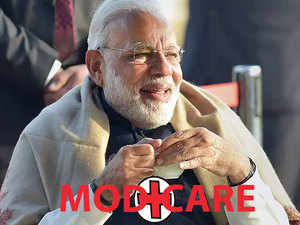By Chaitanya Kalbag

Sometime over the next few weeks — most likely in his Independence Day speech — Prime Minister Narendra Modi will formally launch what has already been billed as the world’s biggest public healthcare programme, Ayushman Bharat, or the National Health Protection Mission (AB-NHPM).
The scheme was announced in the 2018-19 Budget and approved by the Cabinet in March. It will vault over all other social welfare projects of the NDA government, lik Swachh Bharat, free LPG connections to the poorest families, electricity to all homes, and Jan Dhan bank accounts.
It will take years for Ayushman Bharat to be rolled out, but it will gratify what you might call the final-year itch. These go-for-broke compulsions kick in several months before a general election. They are always pro-poor, populist and profligate.
To recap, Ayushman Bharat will target 107.4 million ‘poor and vulnerable’ families identified by the 2011 Socio Economic and Caste Census — at least 500 million individuals, or about 40% of the population. (Never mind that by the time it is in place, these numbers will be nearly a decade old and probably an underestimate.) A defined-benefit scheme, Ayushman Bharat guarantees insurance of up to Rs 5 lakh per family for secondary and tertiary healthcare. Beneficiaries will pay no premium, and the central and state governments will share the premium costs.
How much will it cost? Officials I spoke with estimate the average premium will not exceed Rs 1,000 per family. So, full enrolment may cost the exchequer up to Rs 10,000 crore. (Nagaland has quoted an annual premium of only Rs 444 per family.)
As welfare schemes go, Ayushman is dwarfed by the Rs 1.43 trillion spent by the government on food subsidies under the National Food Security Act (NFSA) in 2017-18. NFSA was pushed through by UPA 2 in September 2013 — a few months before a general election that it lost. It is also important to remember that none of these schemes is an Eureka innovation. They are based on, and expand, an idea that somebody else thought of. NFSA pledged between 3 and 7 kg of subsidised rice, wheat and coarse grain to over 800 million people, or two-thirds of the population, plus free meals to pregnant women, lactating mothers, malnourished children and the destitute.
More of the Same
Although the BJP criticised the food security scheme, which expanded efforts by previous governments to sell subsidised foodgrains to India’s poorest, it had no option but to implement it. The Modi government, using digitisation of public distribution system (PDS) records, has tried to curb leakages, cancelling 27.5 million fake ration cards, and linked 194 million ration cards to Aadhaar.
Reading between these lines, it is clear it costs a lot to keep millions of Indians in poverty. Although the government is experimenting with direct transfers of food subsidies to beneficiaries, the base prices of rice and wheat are nearly two decades-old and bear no resemblance to market prices — hence the huge subsidies.
Ayushman Bharat will subsume the Rashtra Swasthya Bima Yojana (RSBY), which was launched in 2008 by the UPA government. That was the year the UPA announced three stimulus packages that included a Rs 71,000-crore farm loan waiver. The recklessness continued after the UPA won the election, and the budget deficit hit a ruinous 6.8% of GDP in 2009-10.
As a first stab at near-universal healthcare for the poor, RSBY was a good scheme. It promised annual insurance of Rs 30,000 per family and targeted below poverty line (BPL) families, expanding later to include categories like construction workers, railway porters, street vendors and domestic workers. Beneficiary families used smart cards and only had to pay a one-time Rs 30 registration fee.
RSBY lost momentum after the UPA lost power. Originally designed to cover 70 million households by 2017, the latest data show that it has shrunk to 15 states, and only 36.3 mn families have been enrolled from a targeted total of 59.1 million as of March 2017. RSBY premiums were capped at Rs 750 per family annually.
As you can see, the devil will be in the details of Ayushman Bharat. It will issue e-cards to beneficiary families, but they have to be identified, informed and persuaded to enrol. Most state governments have signed up, including reluctant ones like West Bengal and Rajasthan that had its own Bhamashah programme targeting a wider population. A couple of states are holding out — Odisha, which will go to the polls simultaneously with the Lok Sabha, and Telangana, where the old and more comprehensive Aarogyasri health insurance scheme of the Congress era has been adopted and expanded by the current Telangana Rashtra Samithi (TRS) government.
Right Prescription
Ayushman offers 135 packages, compared with RSBY’s 70. Memoranda of understanding (MoUs) have to be signed with a host of state and private insurers. “The insurers are salivating,” a public health official said, over the potential new business.
In March, Indu Bhushan was lured from a 21-year career with the Asian Development Bank to be the CEO of Ayushman Bharat. Bhushan, who was Director-General of the ADB’s East Asia division, has worked on mass healthcare programmes in Thailand — where the popular 30-baht scheme led to universal coverage — Vietnam and Mongolia. Like Parameswaran Iyer, who left a World Bank job to lead the Swachh Bharat programme, Bhushan is a former IAS officer.
(Disclaimer: The opinions expressed in this column are that of the writer. The facts and opinions expressed here do not reflect the views of www.economictimes.com.)
